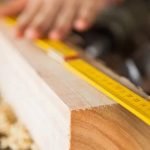Introduction
Before getting to work with wood in the shop, it is essential to understand the importance of proper drying and the technique involved in it. Wood in its natural state contains moisture which can cause warping or splitting if left unchecked, so using freshly harvested lumber is not recommended for woodworking projects. Drying wood slowly and carefully can prevent a wide range of problems later on for woodworking projects and allow for better end-uses.
In order to properly dry wood for use in woodworking, green (unseasoned) logs need to be split up into smaller boards as soon as possible after harvest/millage. This step helps reduce drying time since the exposed surface area increases, helping water evaporate more quickly than when it was contained in the original log form. Next, the individual boards need to be stacked in a manner that allows air uninterrupted access around each piece of lumber, as no two boards should touch one another during the drying process. To further accelerate the drying process even more, these air-dried boards can be kiln dried if desired; however this is usually only done with larger scale commercial lumber operations.
Finally, understanding moisture content plays an important part when working with any type of wood for a project; however different types of woods will have different ideal MC levels depending on what they’re going to be used for. For instance a piece intended for outdoor use would require much drier lumber than one intended only for indoor use due to differences between indoor and outdoor relative humidity levels over time. Properly drying your pieces before beginning a project is always recommended so unexpected movement won’t occur during assembly or finish application which can lead to ruined joints or finishes down the line due to imbalanced moisture content levels among board species/origins or improper construction techniques later down the road.
Identification
When planning a woodworking project, it is important to properly identify the type of wood, moisture content, and desired results. Different species of wood require different drying techniques based on the size and thickness as well as climate, environment, and final use.
The type of wood used can affect shrinkage and checking or cracking that may occur when the wood dries. Hardwoods have higher density and greater potential for shrinkage than softwoods. Softwoods were historically used for structural framing because of their stability even after drying – but hardwoods are more popular now because of their attractive grain patterns. Woodworkers should research which types will best suit the project learning about grain characteristics, workability, dimensional tolerance stability and strength of each species.
Wood moisture content can be measured with a device such as a moisture meter or pinless electronic meter although some woods react more quickly than others making this overall process more complex. Knowing when to stop drying is also critical to prevent damaging the material by drying too much or too little and so making sure that the correct level is reached depends upon accurate measurements.
Knowing what end result is expected and hoped for must be included in considering how wood needs to be dried which includes understanding why over-drying will lead to unstable structures that can warp easily with changes in humidity levels or temperature swings while under-drying will cause increased movement with subsequent exposure to humid air conditions leading to distortion in dimensions or increased checking on exposed surfaces. Finally deciding which method should be used for certain species in comparison with your tools and skills you possess. Achieving wooden furniture pieces which embody both beauty and longevity requires knowledge from various sources but mainly from practical experience combined with consistent quality checks at crucial stages during manufacture as well as proper pre-treatment prior to working on it – such as drying it out correctly!
Drying Method #1
When drying wood for woodworking, there are two main techniques: natural air-drying and kiln drying. Natural air-drying is a slow but reliable way to dry wood for projects. This requires stacking the lumber in an open space like your garage or yard in order to allow it to dry out over time. Begin by sorting the pieces of lumber into piles according to size, shape and type of wood so that air can pass easily between the pieces. Next, place a plastic sheeting or tarp beneath the stack to protect from any moisture from coming up from the ground; use sticks or small logs to keep the plastic sheeting elevated off of the ground if needed. Before stack building begins, seasonally wipe down all exposed faces with mineral spirits which will strip away dirt, dust and debris prior to accumulation during air-drying time. After stack building is finished, ensure all sides have good ventilation (even on top) and cover the top layer with plastic sheets or tarps when necessary. Depending on climate conditions, it can take anywhere from 6 months up to 2 years for fully seasoned lumber- make sure you check your stocks every few months as some pieces may be ready sooner than others!
Drying Method #2
In order to properly dry wood for woodworking, one method is to use active heat in kilns. Using an active kiln involves the application of a forced heated air flow to the wood and using continuous ventilation levels to keep the environment stable in terms of moisture content. The temperature is slowly increased over time, allowing the moisture within the wood to be released, and helping it reach the desired level for woodworking. Monitor equipment like humidity gauges and temperature recorders are often used with this method as they allow for greater flexibility when it comes to drying times. It should be noted that not all types of wood can tolerate active heat and certain species do better when dried more slowly with lower temperatures. Nevertheless, this is an efficient manner to complete a suitable drying process when done correctly. Ultimately, enhanced and longer lasting results are yielded with proper care taken throughout the entire process.
Drying Method #3
Solar drying is a very budget-friendly way of drying wood. This method requires minimal investment, and involves exposing pieces of freshly cut lumber to the sun. With solar drying, you’ll want to let the wood sit in direct sunlight for about two days, or until it reaches your desired moisture level.
Another advantage of utilizing solar drying is that you won’t need to pay for a kiln or rent a facility to control moisture levels. Just use the power of the sun! However, solar drying does require consistent monitoring due to frequent shifts in temperature and humidity in an outdoor environment. Also note that if temperatures are too low (early morning or late evening) wood can retain a higher moisture content and become vulnerable to decay from fungal infections. Therefore, it’s important to pay extra attention during this time period. Additionally, when using solar drying with thicker pieces of lumber, like large beams and support posts, flip them every 2-3 days so all sides are exposed evenly. Finally, plan your project accordingly and afterwards store the dried wooden pieces in tightly sealed wrapping paper or plastic sheeting; this will further help prolong their shelf life.
Quality Control
Properly drying wood is essential for any successful woodworking project. Controlling the environment in which the wood will reside during the drying process is key to keeping the grain of the wood strong and intact. The most important aspect of quality control when it comes to properly drying wood is identifying an appropriate space with adequate air circulation. This space should be both dry and warm, as excessive moisture and cold can cause harm to the grain of the wood.
Another key factor in assessing quality control is understanding the species of tree that you are dealing with. Different types of trees take varying amounts of time and temperature change for their grains to properly set during drying processes. It’s necessary to research this information before trying to dry any wood species so that temperatures remain constant throughout each step of the process.
Finally, ensuring proper seasoning is critical for high-quality pieces during drying processes. A minimum seasoning period must occur before kiln-drying or air-dryingwoods; otherwise, warping or excess splitting may occur during this stage, ruining your workpiece in an instant. The optimal seasoning period is 8 weeks minimum and a month per inch in thickness; however, this varies depending on available resources as well as type of tree being dried – softwood or hardwood – so researching specifics prior to beginning work is recommended not just for quality control but also safety reasons as well.
Safety First
Safety should always be the main priority when drying wood for woodworking. This includes both taking safety precautions with electricity, combustibles, and sharp edges, and also properly selecting, splitting, stacking and monitoring the wood. Starting with a suitable selection of wood is essential. The tree’s growth patterns such as knots, branches, size and bark matter in the type of cut-wood you will use for your project. For larger pieces of lumber, a chainsaw can be used to take down trees or split them from their standing stumps; while a bow saw or hand saw can carefully maneuver smaller lumber sections.
When splitting logs using an axe or maul to make kindling, simple steps need to be taken so as not to come into contact with sharp edges or incur any injuries. Splitting should not only be done on level ground; but protective headwear and eyewear should also be worn at all times. After splitting your logs, stack in a well ventilated place out of direct sunlight per the species instructions then cover with a tarp during extreme weather conditions like rain and snow storms.
Using dampness meter probes or moisture meters are bound to give accurate readings on the levels of moisture in each piece of wood including air temperature for better results.. It is important to change probes regularly due to wear after monitoring more than one board over time. As you dry each piece of wood monitor it closely to detect problems that might lead to warping or cracking ” paying attention to sudden changes in baking will help achieve that nicely finished dryness in your project boards quickly yet safely.
Maintenance
Wood drying is an important step when working with wood in any form of woodworking. Improper drying can cause serious problems down the line, leading to splitting or cracking of the wood pieces due to movement in humid conditions. Therefore, proper long-term storage of the dried wood is essential for protection against moisture damage. The following tips should help ensure that your dried wood remains stable and safe for use in your projects.
1. Store in a cool, dry place: It’s important to avoid storing your dried wood in areas where it will be exposed to direct sunlight or other sources of heat that can induce huge swings in humidity levels which can damage otherwise dry wood. Finding a cool, dark place like a basement below ground level or a closet away from windows helps minimize the risks.
2. Keep out water: It sounds obvious but even tiny contact with liquid water can create problems for stored dried wood. If you must store outside, purchase waterproof containers and cover them with plastic sheeting when it rains and snows to prevent moisture from seeping through into the stored wood material directly beneath it.
3. Use moisture absorbers: Moisture absorbers such as silica gels are great additions to dry-wood storage spaces as these absorb any builds up of humidity that may not be noticeable until it is too late; this drastically decreases the chance of moisture damage while stored over long periods of time.
4. Check regularly: Even with all these precautions, you should still check on your stored dried-wood periodically (once per season at least) to make sure there aren’t any signs of mould or cracking due to shifting humidity levels or invisible water leakage nearby ” both are easily preventable if caught early enough!
Conclusion
Drying wood is one of the most important steps in woodworking, as it must be done properly for maximum strength, structural integrity and aesthetic appeal. The type of drying depends on the type of material you are working with, the amount of moisture it holds and its destination in your project. With this guide, you have everything you need to know about drying lumber for woodworking projects. Understanding different methods and materials used to dry lumber, as well as proper storage techniques will help ensure that your results are always optimal. Whether you’re a professional or a hobbyist, understanding the basics of proper drying methods for each type of lumber will help ensure successful projects every time!

Hi everyone! I’m a woodworker and blogger, and this is my woodworking blog. In my blog, I share tips and tricks for woodworkers of all skill levels, as well as project ideas that you can try yourself.





